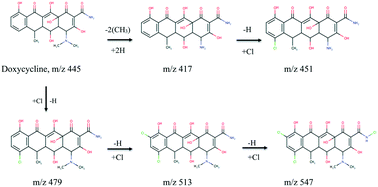当前位置:
X-MOL 学术
›
Environ. Sci.: Water Res. Technol.
›
论文详情
Our official English website, www.x-mol.net, welcomes your
feedback! (Note: you will need to create a separate account there.)
Doxycycline transformation and emergence of antibacterially active products during water disinfection with chlorine
Environmental Science: Water Research & Technology ( IF 3.5 ) Pub Date : 2017-08-15 00:00:00 , DOI: 10.1039/c7ew00215g Nicole L. Kennedy Neth 1, 2, 3 , Clifford M. Carlin 2, 3, 4, 5 , Olya S. Keen 1, 2, 3
Environmental Science: Water Research & Technology ( IF 3.5 ) Pub Date : 2017-08-15 00:00:00 , DOI: 10.1039/c7ew00215g Nicole L. Kennedy Neth 1, 2, 3 , Clifford M. Carlin 2, 3, 4, 5 , Olya S. Keen 1, 2, 3
Affiliation

|
This study identified transformation products of doxycycline that formed during chlorine disinfection and evaluated the antibacterial properties of the products. Samples were analyzed by HPLC/MS/MS to identify the products. Antibacterial activity assays were used to determine the antibacterial properties of the products that formed during chlorine disinfection. Samples were run in both ultrapure water and final effluent collected from a local wastewater treatment facility. The ultrapure water experiments allowed the products to be easily detected, and the identified products were compared to those found in the wastewater matrix. Wastewater effluent was used as a realistic background matrix for a full-scale wastewater chlorination process. Products with antibiotic properties formed in ultrapure water. In the wastewater effluent, antibacterially active products did not form to a measurable extent. Five transformation products were seen in ultrapure and wastewater effluent samples. Both chlorinated and non-chlorinated transformation products were observed. While the same products were found in both matrices, their relative abundance was different; the non-chlorinated product forming preferentially in the wastewater matrix and chlorinated products forming in greater abundance in the ultrapure water matrix. This can be attributed to the competition for chlorine with the wastewater background, inhibiting the formation of active products. Furthermore, bromide was added at concentrations of 0.5–5 mg L−1 to both ultrapure water and wastewater matrices to assess the antibacterial activity of brominated products. The brominated products were observed, although none of them exhibited antibacterial activity. The results suggest that not only trace antibiotics but also their products could be the source of antibiotic resistance in the environment. The fate of other common antibiotics in water chlorination should be examined.
中文翻译:

用氯水消毒过程中强力霉素的转化和抗菌活性产物的出现
这项研究鉴定了在氯消毒过程中形成的强力霉素的转化产物,并评估了这些产物的抗菌性能。通过HPLC / MS / MS分析样品以鉴定产物。抗菌活性测定用于确定在氯消毒过程中形成的产品的抗菌性能。在超纯水和从当地废水处理设施收集的最终废水中运行样品。超纯水实验使产品易于检测,并将识别出的产品与废水基质中发现的产品进行比较。废水用作大规模废水氯化处理的实际背景矩阵。在超纯水中形成具有抗生素特性的产品。在废水中 抗菌活性产物没有形成可测量的程度。在超纯和废水出水样品中发现了五种转化产物。观察到氯化和非氯化转化产物。虽然在两种基质中都发现了相同的产物,但是它们的相对丰度却有所不同。非氯化物优先在废水基质中形成,而氯化物则在超纯水基质中大量富集。这可以归因于氯与废水背景的竞争,从而抑制了活性产物的形成。此外,添加的溴化物浓度为0.5–5 mg L 观察到氯化和非氯化转化产物。虽然在两种基质中都发现了相同的产物,但是它们的相对丰度却有所不同。非氯化物优先在废水基质中形成,而氯化物则在超纯水基质中大量富集。这可以归因于氯与废水背景的竞争,从而抑制了活性产物的形成。此外,添加的溴化物浓度为0.5–5 mg L 观察到氯化和非氯化转化产物。虽然在两种基质中都发现了相同的产物,但是它们的相对丰度却有所不同。非氯化物优先在废水基质中形成,而氯化物则在超纯水基质中大量富集。这可以归因于氯与废水背景的竞争,从而抑制了活性产物的形成。此外,添加的溴化物浓度为0.5–5 mg L 这可以归因于氯与废水背景的竞争,从而抑制了活性产物的形成。此外,添加的溴化物浓度为0.5–5 mg L 这可以归因于氯与废水背景的竞争,从而抑制了活性产物的形成。此外,添加的溴化物浓度为0.5–5 mg L-1对超纯水和废水基质均适用,以评估溴化产品的抗菌活性。观察到溴化产物,尽管它们均未显示出抗菌活性。结果表明,不仅微量抗生素,而且其产品也可能是环境中抗生素耐药性的来源。应检查水氯化中其他常见抗生素的命运。
更新日期:2017-10-27
中文翻译:

用氯水消毒过程中强力霉素的转化和抗菌活性产物的出现
这项研究鉴定了在氯消毒过程中形成的强力霉素的转化产物,并评估了这些产物的抗菌性能。通过HPLC / MS / MS分析样品以鉴定产物。抗菌活性测定用于确定在氯消毒过程中形成的产品的抗菌性能。在超纯水和从当地废水处理设施收集的最终废水中运行样品。超纯水实验使产品易于检测,并将识别出的产品与废水基质中发现的产品进行比较。废水用作大规模废水氯化处理的实际背景矩阵。在超纯水中形成具有抗生素特性的产品。在废水中 抗菌活性产物没有形成可测量的程度。在超纯和废水出水样品中发现了五种转化产物。观察到氯化和非氯化转化产物。虽然在两种基质中都发现了相同的产物,但是它们的相对丰度却有所不同。非氯化物优先在废水基质中形成,而氯化物则在超纯水基质中大量富集。这可以归因于氯与废水背景的竞争,从而抑制了活性产物的形成。此外,添加的溴化物浓度为0.5–5 mg L 观察到氯化和非氯化转化产物。虽然在两种基质中都发现了相同的产物,但是它们的相对丰度却有所不同。非氯化物优先在废水基质中形成,而氯化物则在超纯水基质中大量富集。这可以归因于氯与废水背景的竞争,从而抑制了活性产物的形成。此外,添加的溴化物浓度为0.5–5 mg L 观察到氯化和非氯化转化产物。虽然在两种基质中都发现了相同的产物,但是它们的相对丰度却有所不同。非氯化物优先在废水基质中形成,而氯化物则在超纯水基质中大量富集。这可以归因于氯与废水背景的竞争,从而抑制了活性产物的形成。此外,添加的溴化物浓度为0.5–5 mg L 这可以归因于氯与废水背景的竞争,从而抑制了活性产物的形成。此外,添加的溴化物浓度为0.5–5 mg L 这可以归因于氯与废水背景的竞争,从而抑制了活性产物的形成。此外,添加的溴化物浓度为0.5–5 mg L-1对超纯水和废水基质均适用,以评估溴化产品的抗菌活性。观察到溴化产物,尽管它们均未显示出抗菌活性。结果表明,不仅微量抗生素,而且其产品也可能是环境中抗生素耐药性的来源。应检查水氯化中其他常见抗生素的命运。











































 京公网安备 11010802027423号
京公网安备 11010802027423号